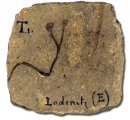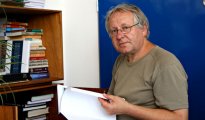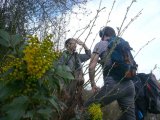GLÚ in the media
News in karst research at the Institute of Geology
Staff of the Institute of Geology of the Czech Academy of Sciences have been long participating in the exploration and research in karst areas, not only in the Czech Republic. Their effort resulted in discoveries of new caves, abysses and other karst phenomena, and yielded considerable scientific knowledge. A few days ago, the media released two interesting news documenting the cooperation of the Institute of Geology within speleological-geological projects. One of these activities brought a major discovery of new large caves in central China (for details click here and here). Another news relates to the co-operation on cave research in the Krkonoše Mts. (for details click here and here).
Cooksonia barrandei – the oldest known terrestrial vascular plant
Cooksonia barrandei, the oldest known (432 million years old) terrestrial vascular plant, was described by a team of authors including Milan Libertín, Jiří Bek and Petr Štorch of the Institute of Geology of the Czech Academy of Sciences. The paper was published in the scientific journal Nature Plants (IF 10.300). For more details see the original paper or an article of the popular scientific journal Vesmír supplemented by a video (in Czech).
A documentary on rock arches
“Mysterious force controlling sandstone erosion”, “The spirit of rocks”, “The intelligent organism”, “Mystery of rock arches solved after 150 years”: those were some of the titles presented by media from all over the world at the break of July and August 2014. Of course, it was an exaggeration and a commitment of the journalists to attract the audience... and to sell. This mass-media avalanche was triggered by a paper published in the NATURE Geoscience journal. This paper was the first to demonstrably prove the principle essential for the evolution of rock arches and some other well-known sandstone monuments. The idea was so simple that many were of the opinion it must have been published many years before. If you attempted to learn something more about this idea, however, you failed in your search in scientific papers and monographs.
Now, in the year 2018, this discovery was released onto television screens and into the internet realm in the form of a documentary.
For the above mentioned original publication, see and for a popular article in Czech, see.
Some of the responses to the scientific research can be found on this webpage.
How much dust is there floating in the atmosphere? Up to five billion tons every year, a geologist says
Tomáš Hrstka, the current leader of the Atmospheric Dust Project of the Strategy AV21 programme, was invited to Czech Radio to talk (in Czech) about the present trends of this hazardous component in our everyday environment. At this occasion, he also mentioned a new technique which has been applied: fully automated, high-throughput analyses of element and mineral compositions applied to samples of dust deposits. Tomáš Hrstka has significantly contributed to the development of these techniques internationally.
Václav Cílek's book was reviewed in The Times Literary Supplement
A wide review of the book of essays "To Breathe with Birds" was published in The Times Literary Supplement (London) on January 29, 2016. You can read the review by Kapka Kassabova here.
Mercury environmental problem - Tomáš Navrátil and Jan Rohovec in the Czech Radio Plus –Leonardo Magazine
Mercury-containing thermometers were withdrawn from the market over six years ago. Amalgam dental fillings are on a retreat, nutrition experts warn against mercury-contaminated fish, and mercury was one of the main suspects in the case of Tycho de Brahe death. Is mercury really so dangerous? And what risk does it really pose for our health and for the environment? A view of geochemists is presented by Tereza Burianová.
The recorded broadcast is here (in Czech)
An article about Leona Chadimová was published in the Vesmír journal (in Czech)
Marek Janáč published an article "Leona Chadimová: Beauties in the Dust" of the series "I work for the Czech Academy of Sciences" in No. 11 of the Vesmír journal. It deals not only with research activities of our colleague but also with her own pathway to science.
Wild Nature of Prague
The Academia publishing house recently released a rather unusual guidebook of Prague, titled “Divoká příroda Prahy” (Nature wilderness of Prague). “It offers a completely different perspective of the city, searching for nature that develops spontaneously, with limited human interference”, says geologist Radek Mikuláš, one of the authors.
Click here for an interview including an audio recording fot the English broadcast of the "Radio Praha".
Radek Mikuláš in the Meteor radio programme
The recently published book “Wild Nature of Prague and its Close Surroundings” is authored by geologist Radek Mikuláš and botanist J.A. Šturma. In this book, the authors explain that the “wild nature” develops rather spontaneously, regardless of human intentions. This may happen in the mountains as well as in an abandoned quarry, or on a slope afforested a hundred years ago. Such a slope in the Barrandov city district, vegetated by a wild forest, was visited by the authors, accompanied by – somewhat surprised – newsmen from the Czech Radio.
The recorded broadcast is here (in Czech)










